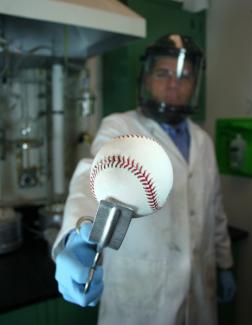The John Bohn lab at JILA owes its very existence to a 2002 decision by the Colorado Rockies to begin storing baseballs in a room with ~50% humidity. The conventional wisdom at the time was that Denver’s thinner air was responsible for making Coors Field a hitter’s heaven. In mile-high Denver, hitters averaged two more home runs per game because the thinner air caused a given home run ball to travel 20 feet further than at sea level. The humidified baseballs were supposed to solve the problem by making it harder to hit the balls over the fence. What’s more, the strategy appears to be working. For the past 5 years, the balls just haven’t been flying out of the park like they used to.
This seemingly straightforward development recently piqued the interest of a couple of intrepid theoretical physicists at JILA who just happened to be ardent Colorado Rockies fans. They already knew that other researchers had shown that humidified balls are less bouncy, so they don’t get as much speed off the bat, traveling about 6 feet less far on average. However, was this effect enough to explain why humidifying the baseballs has obliterated “hitter’s heaven” in Denver?
The truth is, the Bohn lab didn’t know. What they did know was that it’s hard to ascribe a big change in homeruns to a single cause. So they decided to look around for others. Bohn’s graduate student Ed Meyer chose to study the effects of humidity on baseball aerodynamics (an obvious option) for his Comps II project. A quick consultation with advisor Bohn led a plan to gather real data to plug into Ed’s model describing baseball aerodynamics. The Bohn lab (at the PIs own expense) soon acquired three plastic boxes (humidors) and the means to keep five baseballs inside each of them either “dry,” [32% relative humidity (RH)] “moist,” (56% RH) or “wet” (74% RH). The moist balls in their experiment were similar to the 10–12 dozen balls stored in the humidified room at Coors Field.
Meyer carefully measured changes in the diameter and mass of the baseballs as a function of relative humidity. Then the researchers modeled trajectories for pitched and batted baseballs to see whether there were any differences between balls stored at 30% RH versus 50% RH. The results were clear: Drier baseballs should curve slightly more than humidified ones. And, more important for the analysis of home run behavior, drier balls are likely to travel about 2 feet less far when batted. From the perspective of aerodynamics, moist balls would be a bit more likely to yield home runs. So, thanks to Meyer and Bohn, we now know that humidified balls travel about 2 feet farther because of aerodynamics. We already knew they traveled 6 feet less far because of reduced bounciness. However, there may be other reasons why humidified balls can compensate for Colorado’s thin air. For one thing, the players report a difference in the feel, or grip, of a moist ball.
JILA’s experimental sports physics team plans to take this observation seriously. It wants to investigate the effect of humidity on the ability of pitchers to grip a baseball and put more spin on it. Meyer hypothesizes that most of the absorbed humidity gets stored in the hide, making it easier for a pitcher to feel the seams and control the ball. The best way to test this idea would be for the die-hard Rockies fans in the Bohn lab to borrow a real live major-league pitcher from “their” team and make some precise measurements of pitching speed and spin with balls of differing relative humidity. This seminal experiment in baseball physics simply cannot be done with a pitching machine.
Meyer admits his proposed experiment could well be a “pipe dream,” however. Professional baseball players are hard to come by in an experimenta



 The Physics Frontiers Centers (PFC) program supports university-based centers and institutes where the collective efforts of a larger group of individuals can enable transformational advances in the most promising research areas. The program is designed to foster major breakthroughs at the intellectual frontiers of physics by providing needed resources such as combinations of talents, skills, disciplines, and/or specialized infrastructure, not usually available to individual investigators or small groups, in an environment in which the collective efforts of the larger group can be shown to be seminal to promoting significant progress in the science and the education of students. PFCs also include creative, substantive activities aimed at enhancing education, broadening participation of traditionally underrepresented groups, and outreach to the scientific community and general public.
The Physics Frontiers Centers (PFC) program supports university-based centers and institutes where the collective efforts of a larger group of individuals can enable transformational advances in the most promising research areas. The program is designed to foster major breakthroughs at the intellectual frontiers of physics by providing needed resources such as combinations of talents, skills, disciplines, and/or specialized infrastructure, not usually available to individual investigators or small groups, in an environment in which the collective efforts of the larger group can be shown to be seminal to promoting significant progress in the science and the education of students. PFCs also include creative, substantive activities aimed at enhancing education, broadening participation of traditionally underrepresented groups, and outreach to the scientific community and general public.